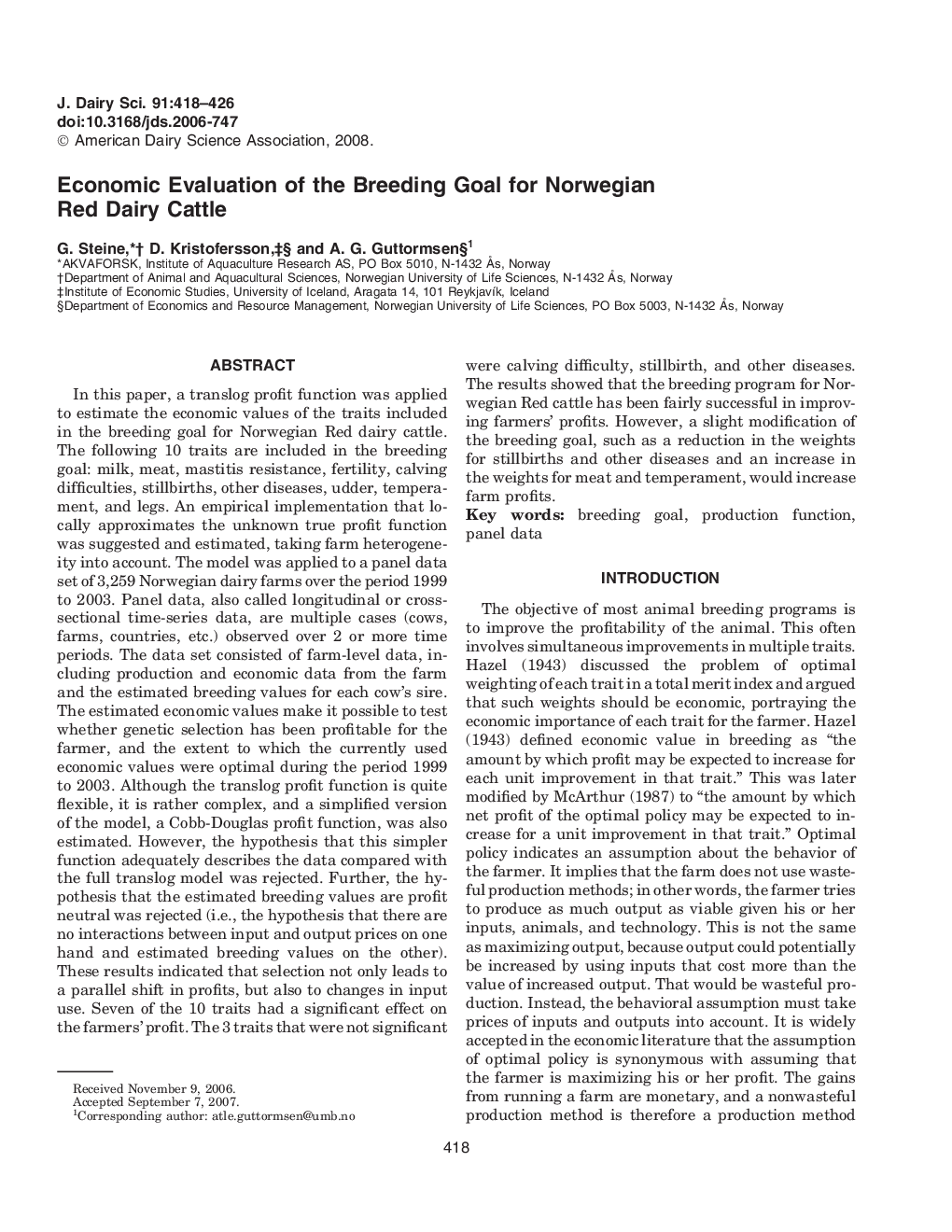| کد مقاله | کد نشریه | سال انتشار | مقاله انگلیسی | نسخه تمام متن |
|---|---|---|---|---|
| 2439599 | 1108100 | 2008 | 9 صفحه PDF | دانلود رایگان |
عنوان انگلیسی مقاله ISI
Economic Evaluation of the Breeding Goal for Norwegian Red Dairy Cattle
دانلود مقاله + سفارش ترجمه
دانلود مقاله ISI انگلیسی
رایگان برای ایرانیان
موضوعات مرتبط
علوم زیستی و بیوفناوری
علوم کشاورزی و بیولوژیک
علوم دامی و جانورشناسی
پیش نمایش صفحه اول مقاله

چکیده انگلیسی
In this paper, a translog profit function was applied to estimate the economic values of the traits included in the breeding goal for Norwegian Red dairy cattle. The following 10 traits are included in the breeding goal: milk, meat, mastitis resistance, fertility, calving difficulties, stillbirths, other diseases, udder, temperament, and legs. An empirical implementation that locally approximates the unknown true profit function was suggested and estimated, taking farm heterogeneity into account. The model was applied to a panel data set of 3,259 Norwegian dairy farms over the period 1999 to 2003. Panel data, also called longitudinal or cross-sectional time-series data, are multiple cases (cows, farms, countries, etc.) observed over 2 or more time periods. The data set consisted of farm-level data, including production and economic data from the farm and the estimated breeding values for each cow's sire. The estimated economic values make it possible to test whether genetic selection has been profitable for the farmer, and the extent to which the currently used economic values were optimal during the period 1999 to 2003. Although the translog profit function is quite flexible, it is rather complex, and a simplified version of the model, a Cobb-Douglas profit function, was also estimated. However, the hypothesis that this simpler function adequately describes the data compared with the full translog model was rejected. Further, the hypothesis that the estimated breeding values are profit neutral was rejected (i.e., the hypothesis that there are no interactions between input and output prices on one hand and estimated breeding values on the other). These results indicated that selection not only leads to a parallel shift in profits, but also to changes in input use. Seven of the 10 traits had a significant effect on the farmers' profit. The 3 traits that were not significant were calving difficulty, stillbirth, and other diseases. The results showed that the breeding program for Norwegian Red cattle has been fairly successful in improving farmers' profits. However, a slight modification of the breeding goal, such as a reduction in the weights for stillbirths and other diseases and an increase in the weights for meat and temperament, would increase farm profits.
ناشر
Database: Elsevier - ScienceDirect (ساینس دایرکت)
Journal: Journal of Dairy Science - Volume 91, Issue 1, January 2008, Pages 418-426
Journal: Journal of Dairy Science - Volume 91, Issue 1, January 2008, Pages 418-426
نویسندگان
G. Steine, D. Kristofersson, A.G. Guttormsen,